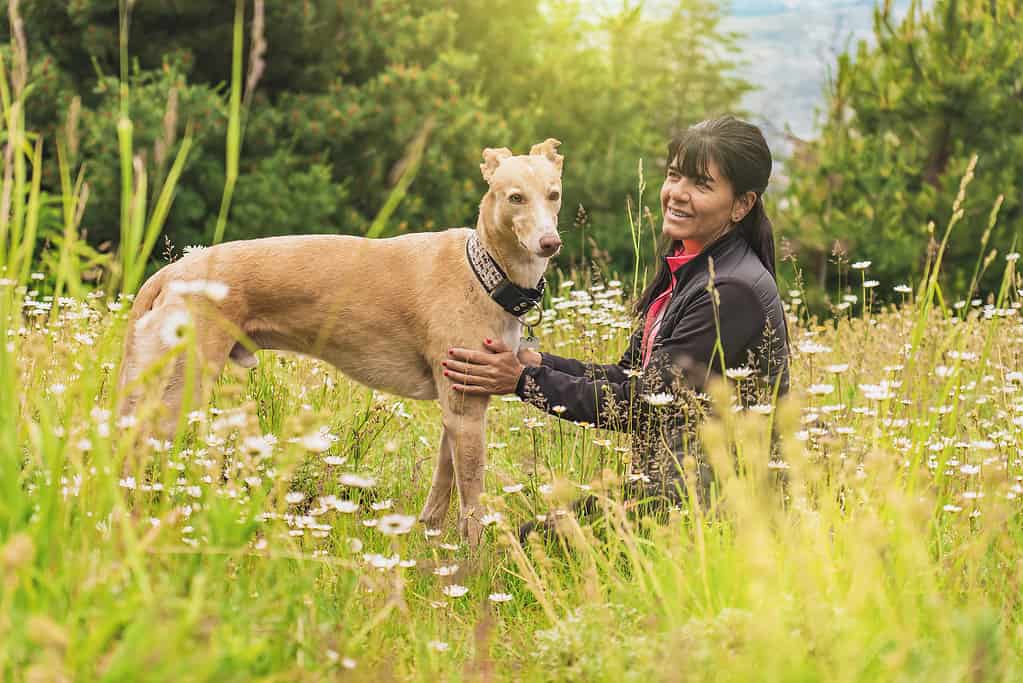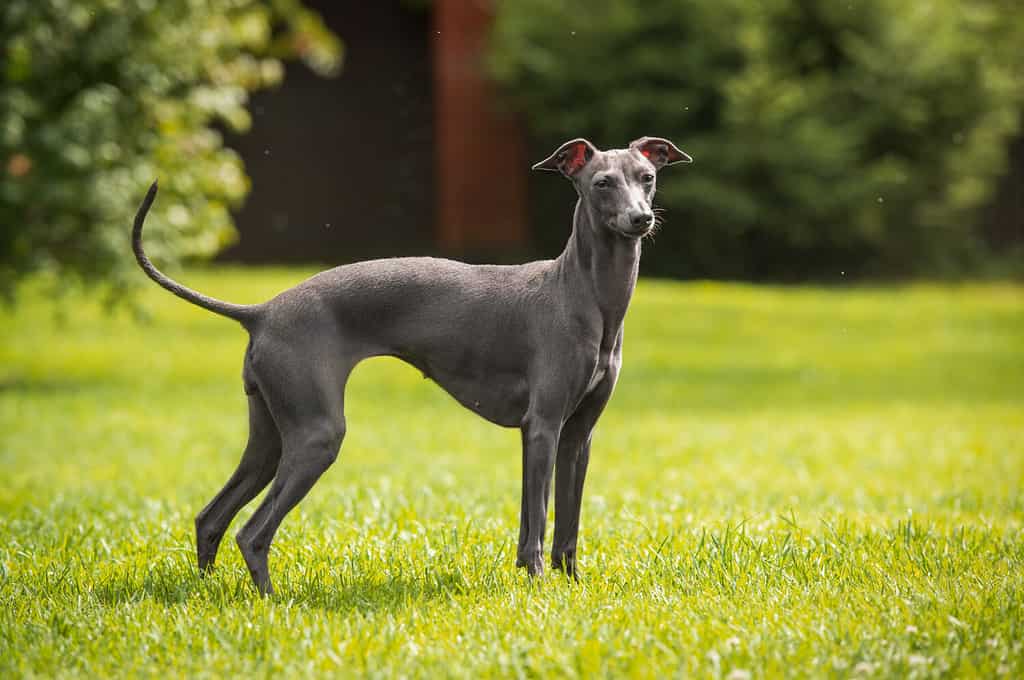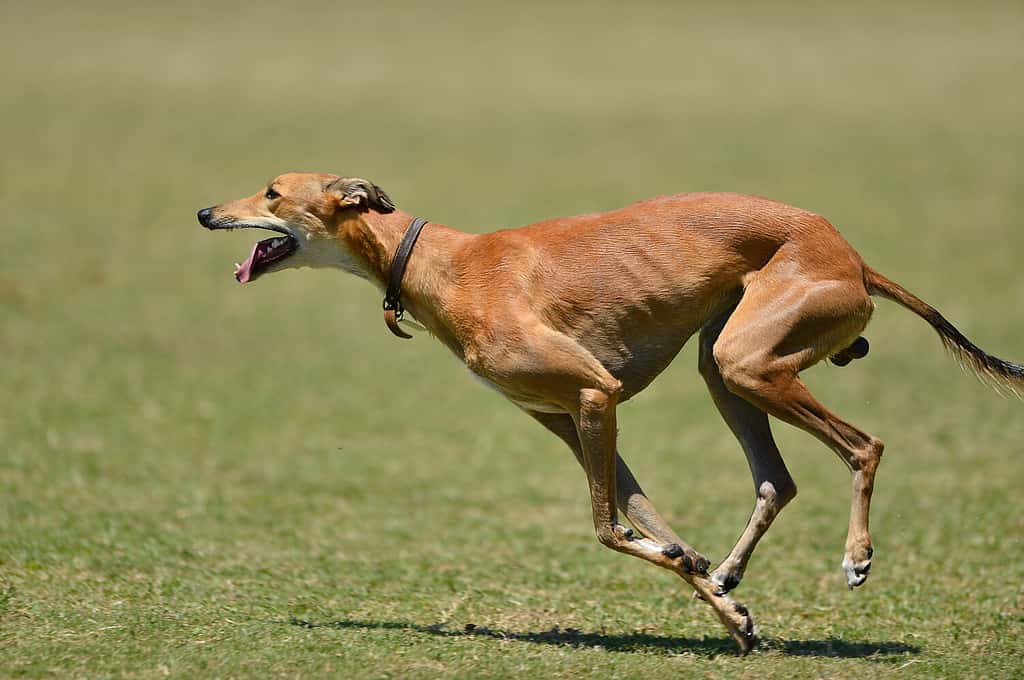Greyhounds are beautiful, docile creatures with bushels of love to give and an incredible work ethic. When it comes to training a greyhound, owners should know several tips, tricks, and methodologies that foster ethical, mutually respectful learning.
Backed by animal behaviorists and veterinarians, discover five methods and tips for how to train your greyhound.
5 Crucial Steps to Follow

Greyhounds like to work with, not for, their owners.
©daniromphoto/iStock via Getty Images
Keep Training Short and Sweet
Greyhounds will lose interest in training sessions quickly if it drags on longer than 10 minutes. Use their energy in several short-burst training sessions of five to 10 minutes rather than a marathon, hour-long session. This gives their brains a chance to digest the cues they’ve learned and keeps the greyhound engaged in the training.
Have Motivating Rewards Handy
Rewards remain vitally important to teach and reinforce cues when training a greyhound! Keep them handy to maintain consistency in your reward structure. Otherwise, your greyhound will become confused about if their action was correct.
Never Use Intimidation or Fear
Training a greyhound requires compassion, patience, consistency, and love. Using fear-based tactics like yelling, shock collars, leash tugging, or anything similar degrades the trust and relationship you’re attempting to build.
Avoiding Rushing Cues
It’s exciting once your greyhound finally understands a cue and gets it right a few times! However, avoid immediately adding more to their plate. Spend time reinforcing the cue, taking a break and playing, and coming back to the cue again. Rushing through new cues will confuse your greyhound and frustrate you both.
Find a Distraction-Free Area
Greyhounds love to chase — it’s in their blood and DNA. When it’s time for a training session, attempt to find a secured area (like a fenced-in backyard or empty dog park) that allows your greyhound off the leash but doesn’t have a litany of distractions they must ignore while also trying to listen to you.
Common Mistakes Made While Training Greyhounds

Consistency is key when training greyhounds.
©Alexandra Morrison Photo/Shutterstock.com
Owners are only human, and it’s easy to make one or two mistakes when training a greyhound puppy — especially if it’s your first time training! Here are some of the most common mistakes made when training greyhounds, as well as a few ways to avoid making these mistakes in the future.
Inconsistency
Inconsistency remains a primary pitfall in all dog training. Avoid inconsistency by making a plan for your greyhound’s training, holding to specific tenets (like always starting the training with your treat bag, doing it at the same time every day, etc.), and putting yourself in the right frame of mind to work with your dog.
Giving Treats Too Slowly
Despite the greyhound’s intelligence, giving treats too slowly can confuse and reinforce the wrong behaviors. As soon as your greyhound completes the task or cue you’ve asked them to perform, reward them. Do your absolute best to remain consistent with this practice to clearly define to your greyhound what they did correctly.
Speaking Harshly
Greyhounds need a gentle, firm hand — not someone to yell at them. If you become frustrated or lose your temper, do your best to still speak in a calm tone. The breed tends to be more sensitive than others so changes in voice inflection mean more to them. Greyhounds want to learn along with you, not work for you, and harsh words will ostracize them from both the training and you as an owner.
Bribing, Not Reinforcing
Bribing doesn’t teach; it’s simply the promise of something good happening if you greyhound chooses to listen. Reinforcement, on the other hand, provides a positive outcome that directly correlates to a behavior — which also builds the thought in your greyhound’s mind that that positive outcome will be more likely to happen in the future if they behave the same way.
Watch your training, especially when you’re tired. Don’t pull out a treat before the action is performed and then reward it; this simply creates a greyhound who will only listen when a treat is present.
Are Greyhounds Easy to Train?

New owners may struggle to keep their patience with stubborn greyhound puppies.
©Eve Photography/Shutterstock.com
As a breed, experts rate greyhounds as middle-of-the-road on an “easy to train” scale. According to the American Kennel Club, greyhounds score 3 out of 5 on a list where 1 is the most self-willed and 5 is eager to please.
Greyhounds like to work; they were bred to hunt by sight, not scent or sound (hence their membership of the sighthound group). As such, the independent spirit of a greyhound following its instincts can prove frustrating for owners not used to the temperament. For owners who educate themselves on what motivates greyhounds, which rewards work best, and how and when to take breaks, training becomes much simpler.
Note that breed individuals differ widely based on early life, previous training, and temperament. All breed members do not act the same.
What Cues Do Greyhound Trainers Use?

Greyhounds can run as fast as 45 miles per hour.
©Hector Rivera Casillas/Shutterstock.com
Greyhounds, like other dogs, need the foundational cues of sit, stay, and come to build their bank of human vocabulary and understand what’s needed of them. In addition, some other cues make a greyhound’s life easier and safer alongside their owners. They include:
- Leave it. As a sighthound, greyhounds have an innate drive to chase after small prey — and fast. Leave it keeps your greyhound by your side, where it’s safe.
- Walk. Pulling on a lead isn’t fun for the dog or the owner. Walk enables your greyhound to have a slower pace than their breakneck speed for a leisurely leashed walk.
- Recall. Having a reliable come cue that removes your greyhound from potentially dangerous situations can save their lives.
Depending on lifestyle, trainers and owners may choose to add additional cues to their greyhound’s vocabulary. The above encapsulates the specific cues that provide greyhounds and their owners with boundaries, respectful rules, and a way to understand each other and their needs.
Ready to discover the top 10 cutest dog breeds in the entire world?
How about the fastest dogs, the largest dogs and those that are -- quite frankly -- just the kindest dogs on the planet? Each day, AZ Animals sends out lists just like this to our thousands of email subscribers. And the best part? It's FREE. Join today by entering your email below.
Thank you for reading! Have some feedback for us? Contact the AZ Animals editorial team.








